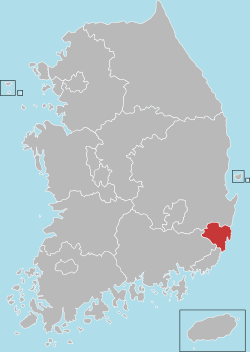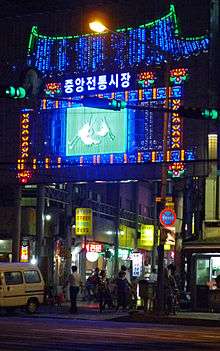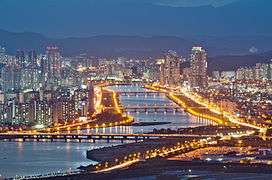Ulsan
| Ulsan 울산시 | |||
|---|---|---|---|
| Metropolitan City | |||
| Ulsan Metropolitan City | |||
| transcription(s) | |||
| • Hangul | 울산광역시 | ||
| • Hanja | 蔚山廣域市 | ||
| • Revised Romanization | Ulsan gwang-yeoksi | ||
| • McCune-Reischauer | Ulsan gwangyŏksi | ||
|
Top:View of downtown Yaeum-dong area, from Mount Shinbulsan, Middle left:Samsan-dong downtown area, Middle right:Iaan Expodium Tower, Bottom left:Ganjeolgot, Bottom right:Taehwagang Train Station | |||
| |||
 Map of South Korea with Ulsan highlighted | |||
| Country |
| ||
| Region | Yeongnam | ||
| Districts | 5 (including 1 county) | ||
| Government | |||
| • Mayor |
Kim Gi-hyeon (김기현) | ||
| Area | |||
| • Total | 1,057.136 km2 (408.162 sq mi) | ||
| Population (October, 2014) | |||
| • Total | 1,163,690 | ||
| • Rank | 8th Korea | ||
| • Density | 1,100/km2 (2,900/sq mi) | ||
| • Dialect | Gyeongsang | ||
| Flower | Pear flower | ||
| Tree | Ginkgo | ||
| Bird | White heron | ||
| GDP | USD $66.1 billion (2015) | ||
| GDP per capita (nominal) | USD $63,817 (IMF, 2016) | ||
| GDP per capita (PPP) | USD $79,623 (2015) | ||
| Website | ulsan.go.kr | ||
Ulsan (Korean pronunciation: [uls͈an]), officially the Ulsan Metropolitan City, is South Korea's seventh largest metropolis with a population of over 1.1 million.[1] It is located in the south-east of the country, neighboring Busan to the south and facing Gyeongju to the north.
Ulsan is the industrial powerhouse of South Korea, forming the heart of the Ulsan Industrial District, which is home to the world's largest automobile assembly plant operated by the Hyundai Motor Company,[2] the world's largest shipyard operated by Hyundai Heavy Industries[3] and the world's second largest oil refinery, owned by SK Energy.[4] In 2012, Ulsan had a GDP per capita of $79,623, the highest of any region in South Korea.
Administrative divisions
Ulsan is divided into 4 gu (districts) and 1 gun (county).
| Map | Name | Hangul | Hanja | ||
|---|---|---|---|---|---|
| Gu (Districts) | |||||
| Buk District | 북구 | 北區 | |||
| Dong District | 동구 | 東區 | |||
| Jung District | 중구 | 中區 | |||
| Nam District | 남구 | 南區 | |||
| Gun (County) | |||||
| Ulju County | 울주군 | 蔚州郡 | |||
Economy

As the center of the Ulsan Industrial District, the city is the corporate base of the multinational Hyundai conglomerate. Up to 1962, Ulsan operated as a fishing port and market centre. As part of South Korea's first five-year economic plan, Ulsan became an open port. Additionally, major industrial plants and factories were developed, including in particular an oil refinery, fertiliser plants, automobile production and heavy industries. The shipbuilding port Bangeojin became part of the city in 1962.
Ulsan is currently the home of the world's largest automobile assembly plant operated by Hyundai Motor,[2] the world's largest shipyard, operated by Hyundai Heavy Industries[3] and the world's second largest oil refinery owned by SK Energy.[4]
Transportation
The city transport department plans to build a light-rail line and the public transportation system is as good as any other major Korean city. The bus system shows a particular ETA at most bus stops.[5] Ulsan Airport, constructed in 1970 and expanded in 1997, has more than 20 flights per day to and from Seoul's Gimpo International Airport and 4 flights per week to and from Jeju International Airport. In November 2010, Korea's high-speed train network, the KTX, was extended to Ulsan.[6] This provides a high-speed link to Seoul, with a running time of just over 2 hours. The new KTX station (Ulsan Station) is in nearby Eonyang, with a series of express buses (5001-5004) as well as some city buses serving the new station.[7] The original city station has been renamed Taehwa River Station.[6]
Sports
The city hosts the K League Classic football club Ulsan Hyundai FC, who, after the 2002 FIFA World Cup, relocated from their former stadium in Jung-gu, which is now a municipal ground, to the Munsu Stadium, which hosted several matches during the 2002 World Cup. Ulsan was home to another football team, Ulsan Hyundai Mipo Dolphin FC, which played in the Korea National League until 2016, when it was dissolved. It is also home to the University of Ulsan. Ulsan also hosts Korean Basketball League team Ulsan Mobis Phoebus. Their home ground is Dongchun Gymnasium, which located in jung-gu ulsan.[8]
Geography
Ulsan is bounded on the east by the Sea of Japan (East Sea). Busan is 70 km to the south.
Climate
Ulsan has a monsoon-influenced humid subtropical climate (Köppen Cfa/Cwa), with somewhat cold but dry winters, and hot, humid summers. Monthly means range from 2.0 °C (35.6 °F) in January to 25.9 °C (78.6 °F) in August, with diurnal temperature ranges generally low. Its location on the Korean peninsula results in a seasonal lag, with the warmest days being in August and averaging very near 30 °C (86 °F). Precipitation is relatively low in the winter months, but is made up by the high rainfall falling from April to September.
| Climate data for Ulsan (1981–2010) | |||||||||||||
|---|---|---|---|---|---|---|---|---|---|---|---|---|---|
| Month | Jan | Feb | Mar | Apr | May | Jun | Jul | Aug | Sep | Oct | Nov | Dec | Year |
| Average high °C (°F) | 7.3 (45.1) |
9.2 (48.6) |
13.2 (55.8) |
19.2 (66.6) |
23.4 (74.1) |
26.0 (78.8) |
28.9 (84) |
30.0 (86) |
25.9 (78.6) |
21.9 (71.4) |
15.8 (60.4) |
9.9 (49.8) |
19.2 (66.6) |
| Daily mean °C (°F) | 2.0 (35.6) |
3.9 (39) |
7.9 (46.2) |
13.5 (56.3) |
17.9 (64.2) |
21.4 (70.5) |
25.0 (77) |
25.9 (78.6) |
21.5 (70.7) |
16.2 (61.2) |
9.9 (49.8) |
4.3 (39.7) |
14.1 (57.4) |
| Average low °C (°F) | −2.3 (27.9) |
−0.7 (30.7) |
3.2 (37.8) |
8.2 (46.8) |
12.8 (55) |
17.3 (63.1) |
21.8 (71.2) |
22.7 (72.9) |
17.9 (64.2) |
11.5 (52.7) |
5.1 (41.2) |
−0.3 (31.5) |
9.8 (49.6) |
| Average precipitation mm (inches) | 34.3 (1.35) |
42.6 (1.677) |
65.8 (2.591) |
91.1 (3.587) |
108.1 (4.256) |
176.8 (6.961) |
232.3 (9.146) |
240.3 (9.461) |
168.2 (6.622) |
53.5 (2.106) |
41.1 (1.618) |
23.0 (0.906) |
1,277.1 (50.28) |
| Average precipitation days (≥ 0.1 mm) | 5.3 | 6.3 | 8.1 | 8.4 | 9.2 | 10.0 | 13.5 | 12.1 | 10.3 | 5.7 | 5.1 | 3.9 | 97.9 |
| Average relative humidity (%) | 49.6 | 51.9 | 57.6 | 60.3 | 66.1 | 73.3 | 78.9 | 77.7 | 75.7 | 67.2 | 59.9 | 52.4 | 64.2 |
| Mean monthly sunshine hours | 190.7 | 176.4 | 187.5 | 207.2 | 215.4 | 172.7 | 151.5 | 167.3 | 150.0 | 193.7 | 182.0 | 194.6 | 2,188.8 |
| Source: Korea Meteorological Administration[9] | |||||||||||||
Tourist attractions
There are 7 tall mountains (Gajisan, Sinbulsan, Ganwolsan, cheonhwangsan, yeongchuksan, Goheonsan, Jaeyaksan) over 1,000m above sea level. Sinbulsan (MT.) Ridge, which changes to a fantastic silver grass field in autumn, is one of the best sights to see in the Yeongnam Alps. Eoksae festival is held every early October in Ganwoljae which is best known for its colony of silver grass.
Oegosan Onggi village
Korea's largest traditional folk Onggi (earthware) village creates a unique scene as the whole village is made of earthware. You can see the first-hand traditional Onggi (earthware) manufacturing process including Onggi workshops and kilns. Try your hand at making Onggi. The Ulsan Onggi museum offers a variety of information related to Onggi and displays a diversity of this eathware.
Jangsaengpo Whale museum & Whale Ecological Experience Hall
As the only whale museum in Korea, Jangsaengpo whale museum collects, maintains and displays whailing-related artifacts, which have been disappearing since 1986 when whailing was prohibited. It also provides a variety of information related to whales and marine ecosystems and is a space for education, research and experience. And You can enjoy ride on whale cruise from Jangsaengpo port.
Grand Parks
- Ulsan Grand Park , it is the best ecology park in a downtown area in Korea, boasting a vast area of 3,640,000 m2 (39,180,634 sq ft). With Natural, Clean and comfortable as the main themes, it is a pleasant place for relaxaion where you can breathe in nature during daily life. This Peaceful and pleasant downtown park is always filled with family visitors as it hosts a variety of experience events and festivals. In particular, the Rose Festival in every June presents the opportunity to enjoy a feast for the eyes with diversity of beautiful roses.
- Taehwagang River Grand Park : Simnidaesup (bamboo grove), one of the 12 scenic beauties of Ulsan, was restored and now the river and the bamboo grove are connected. it is an ecological space that reminds citizens of the importance of nature and environment. It allows visitors the chance to observe and experience wildlife in its natural environment and to relax while being one of nature.
Industrial tour
Ulsan Industry Park, emitting its dazzling lights 365 days a year, has been leading the Pacific Rim industry in the 21st century. Ulsan Has Hyundai Motor Company, with the world's largest single-purpose plant, Hyundai heavy Industries, the biggest heavy industry leader in the world, Hyundai Mipo Shipbuilding, Petrochemical Park, leaders in Korea's chemistry industry.
Coast trip
Ulsan has beautiful beaches (Jinha, Ilsan) and amazing view of Daewangam Park with its lush hundred-year-old pine forest. Specially, Ganjeolgot cape tops the list as the best-known sunrise site, where the sun rises first on the Korean peninsula. A sunrise festival is held every New Year's Day.
 Twilight view of Taehwa River and downtown area
Twilight view of Taehwa River and downtown area Industrial Complex area in Ulsan
Industrial Complex area in Ulsan
In media
Ulsan is one of the filming locations of the Munhwa Broadcasting Corporation 2012 South Korean television melodrama series May Queen, starring Han Ji-hye, Kim Jae-won and Jae Hee.
Twin towns – Sister cities
| City | Region | Country | Year |
|---|---|---|---|
| Hagi | Yamaguchi Prefecture | |
1981 |
| Portland | Oregon | |
1987 |
| Changchun | Jilin | |
1994 |
| Kocaeli Province | |
2002 | |
| Santos | São Paulo | |
2002 |
| Khánh Hòa Province | |
2002 | |
| Tomsk | Tomsk Oblast | |
2003 |
| Wuxi | Jiangsu | |
2006 |
| Montevideo | Montevideo Department | |
2012 |
| Chennai | Tamil Nadu | |
2016 |
Notable People
- Calvin Park All American Track and Field Athlete
See also
- Bangudae Petroglyphs
- List of cities in South Korea
- List of Korea-related topics
- List of oil refineries
- List of South Korean regions by GDP
References
- ↑ "SOUTH KOREA: Cities (registered population)". Citypopulation. Retrieved 21 August 2013.
- 1 2 (Korean) 연합뉴스 : 바른언론 빠른뉴스. Yonhapnews.co.kr (2009-10-16). Retrieved on 2013-07-12.
- 1 2 천혜 절경 바닷가가 세계 최대 조선소로 변모 - 오마이뉴스. Ohmynews.com (2013-01-18). Retrieved on 2013-07-12.
- 1 2 http://pda.ulsan.go.kr/Common/Detail.neo?id=U0010711
- ↑ "Welcome to Ulsan Metropolitan City - News and Notice". Ulsan City Council. Archived from the original on 2008-01-03. Retrieved 2008-02-18.
- 1 2 Ulsan-Seoul high-speed train service to start in November. Koreatimes.co.kr (2010-10-05). Retrieved on 2013-07-12.
- ↑
- ↑ ulsan mobis phoebus basketball team, ulsan mobis phoebus basketball team (2016-04-14). "ulsan mobis phoebus basketball team".
- ↑ "평년값자료(1981–2010) 울산(152)". Korea Meteorological Administration. Retrieved 2011-05-26.
- ↑ "Ulsan Metropolitan City". ulsan.go.kr.
External links
| Wikimedia Commons has media related to Ulsan. |
| Wikivoyage has a travel guide for Ulsan. |
- Ulsan Metropolitan City official site (English)
- Ulsan Metropolitan City official site (Korean)
- Ulsan : Official Site of Korea Tourism Org
- Ulsan's Foreigner Living Site
Coordinates: 35°33′N 129°19′E / 35.550°N 129.317°E



